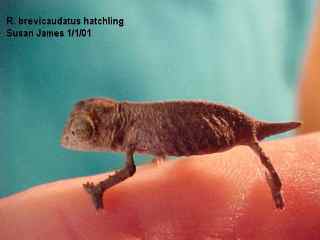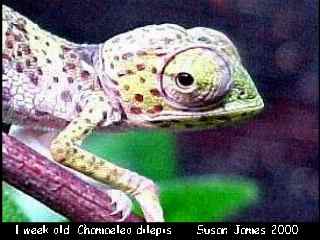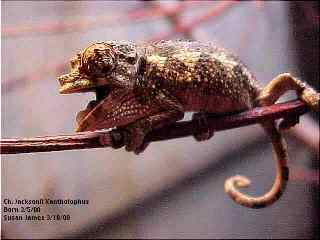|
|
|
|
BABY CARE: birth/hatching to 5 weeks of age
|
| At birth or hatching a baby chameleon is a tiny and fragile thing and the first two weeks of a baby chameleon's life are the most critical although high mortality rates are often observed up to 12 weeks of age. Food, water, and a proper environment are the most important factors contributing to a baby's survival. The following sequence of the birth of a baby C. ellioti gives some sense of this fragility. |
Caging
The number of babies per container should be low and small branches for little feet to grip securely must be provided. Appropriate plants include china doll and Ficus benjamina. Some keepers prefer silk (not plastic) plants because of the greater ease in keeping them clean. The height of these branches is also important. Some breeders like to keep the branches close enough to the floor of the container to allow for hunting feeder insects from the floor as well as from the branches. This method of floor feeding requires that the floor be kept scrupulously clean at all times. Fresh stool deposits can fool the babies into thinking there is a drop of water ready to be consumed. Cup feeding can be better because one can easily replace the cup on a daily basis. |
|
|
|
From the time they emerge from the mother or egg, the babies in a given clutch will exhibit significant variance in size and this variance begins to increase almost immediately. It is advisable, therefore, to separate the babies according to size, housing together only those of similar size. This segregation by size should be a continuing process to counteract the effects of social stress and of competition for food and basking sites. At weekly intervals each cage should be examined to see if the growth of some babies is being stunted. Any babies found to be growing more slowly than the others should be placed in a cage of its own or with other babies of similar size.
|
|
|
|
There are many different types of cages that may be used to house babies. There are, of course, the standard, commercially availably screen cages. An appropriate sized cage for neonates would be approximately 24" x 16" x 16" or smaller. Too large a cage makes it difficult for the babies to find their food. Thirty-gallon Rubbermaid containers have been used successfully as have homemade cages constructed from 2-4 gallon clear plastic barrels. Large panels are cut from the top, sides and bottom and screening is affixed to the barrel with a hot glue gun, silicone sealer, or even a soldering iron used to fuse the screening and plastic. Others prefer glass aquaria. Screen cages have the advantage of being easier to keep clean and to mist without excess water and waste accumulating in the bottom. They also have better air circulation. The advantage of the solid-walled cage has to do with its ability to hold a higher humidity level. For large clutches, multiple cages will be required.
|
|
|
Misting
Water is the key to all living things and a small chameleon who weighs less than 1 gram is in need of water 3 times per day. Because the ratio of surface area to body mass is generally higher in smaller animals, babies will lose water at a proportionally greater rate than will adult animals. Tap water used to mist the babies should be left standing over night in an open container or boiled to permit the chlorine to dissipate. Do not add bleach to the water thinking you are helping your chameleon. The temperature of the water in the sprayer should be no cooler than room temperature and may even be hot since the fine droplets in a mist cool very rapidly. Never use cold water or melting ice cubes to water babies. Misting three times per day is recommended. Care should be taken to mist the sides of the cage, branches and leaves and to avoid direct spraying of the babies. This is because some keepers have reported that babies can actually suffocate if droplets form on their snouts and cover their tiny mouths and nostrils. Direct spraying may also startle the babies and cause them to retreat from the moisture that they require. You should see the chameleon advance to drink. Different keepers have their own preferences for the ideal type of mister ranging from the standard spray bottle to atomizers but all agree that you must observe your babies drinking and ensure that they are not being frightened/stressed by the procedure. Using a wet cricket gutload is also an advantage for the baby chameleons. By using fresh vegetables and fruits as a gutload you can ensure better hydration of the prey items and, therefore, better hydration of the baby chameleons. |
Feeder Insects
At least 4 weeks before you expect to hatch babies you should set up your Drosophila cultures. If you have to toss some away then you are doing it correctly! Twenty babies will devour a large number of Drosophila and it is better to have many cultures producing fruit flies before the births/ hatchings than to have babies before your cultures are ready. D. melanogaster life cycle is 3-5 days in optimum conditions, 80-85 degrees F. The lifecycle of D. hydeii is almost 30 days in optimum conditions, 80-85 degrees F. For the smaller species, D. melanogaster may be preferred but most baby chameleons can handle the larger D. hydeii Drosophila within 30 days and small crickets may gradually be introduced. A varied diet is a good thing for the health of your animal so that small waxworms, silkworms, or baby super worms that have recently shed their exoskeleton, may be offered occasionally to the growing babies. |
 |
| As a general rule, you should strive to have 3-5 actives cultures of fruit flies for every 10 babies. The D. melanogaster are tiny but make up for their small size by prolific breeding. D. hydeii are a little larger but take longer to produce . Depending on the amount of time you have to commit t o raising flies, one or the other will work. Cultures will usually produce flies for 2-4 weeks, so the trick is to start a few new cultures each week in anticipation of the arrival of your baby chameleons. |
|
| Pinhead crickets are one-week old crickets. Commercial cricket breeders will supply you with these small ones as long as you ask them. But make no mistake about it, you must explain to the cricket supplier exactly what you need. Some will refer to these as dust sized, one day old, just hatched, ant sized, etc. If you merely specify "pinheads" you risk receiving crickets anywhere between newly hatched to 2 weeks old. You need to get your point across to the supplier by explaining exactly what you need! Your needs for these very small (newly hatched) crickets will only be 10 to 20 days . These baby crickets will grow quickly! Try not to dump too many into the feeding container at one time. This can cause a baby chameleon to become confused,
unable to decide which one to eat! Some baby chameleons prefer pinheads and some prefer Drosophila. Ideally, both should be offered. |
 |
|
| Fruit flies will disperse all over the cage. You can also coax the fruit flies to concentrate where the baby chameleons can easily find them. This is done by spearing a small piece of fruit or berry on a branch. Because fruit flies can climb virtually any surface, offering them in feeding cups is an exercise in futility. Crickets can be eaten from a cup if you provide one or you may allow them to freely roam the cage. Allowing the crickets to disperse allows the babies to hunt the insects in a more natural manner. Supplying a small amount of cricket food inside the chameleon cage can be a good thing. It will allow any uneaten crickets to remain gutloaded and will minimize the chance that the crickets will attempt to bite the baby chameleons. |
Dietary Supplements
Dietary supplements are as important as a good food supply . Supplements can only become effective as the animals begin to eat larger meals. In tiny hatchlings some dusts can cause intestinal blockage if used improperly. This does not mean you should not use them. There are ways of providing supplements to a one-week old baby without any extra effort by simply using a high quality cricket gut load! At 4 weeks you can begin to apply supplement in dust form if you desire. |
 |
|
|
|
Humidity
How can you keep the humidity high in a baby's cage without soaking everything and facilitating the growth of mold and bacteria? Ultrasonic humidifiers a re a good means of adding humidity to the air in a room but the mist should not be aimed directly at the cage. A basic quick fix also is to dampen a towel or other clean cloth. Drape it over the cage and it will add humidity to the air. This is a quick fix! Adding a 16 oz. deli cup on the top of this cloth with a pin hole in the bottom allowing water to drain onto the cloth adds humidity for longer periods of time. Using real plants and spraying them 1-3 times daily will also increase humidity levels. Having large plants in the room keep animals in need of higher humidity levels can also be of help. Closing the door to this room will also help keep humidity higher. A water dish with river rocks filled with water will disperse some humidity but the dish (and rocks) must be cleaned frequently. Alternately, a water bowl may be placed in the cage but the bowl must be covered by screening to prevent accidental drownings and the bowl must be cleaned frequently. |
Temperature
This is the most commonly asked question. Unfortunately, there is no single, universally agreed upon answer. What is agreed, however, is that babies are more sensitive to overheating than are adults. The amount of time spent basking can vary greatly. But all babies need to bask. You will recognize basking when your babies turn their bodies to lean toward the sun or artificial lighting and darken themselves, thereby regulating body temperature. If the babies begin to move away from the light and retreat to cooler places it is time to remove them from the high temperature s. Because of the high surface area to body mass ration in babies, they can overheat very quickly. It is preferable to err on the side of cooler temperatures. Basking can occur three time daily during the babies first few weeks. Water can be supplied after basking. Real sunlight is what all the bulb manufacturers are trying to simulate and some of these bulbs work just fine. When in doubt, use real sunlight for brief periods of 10 to 15 minutes at a time. Big hint here: set a timer of some type to remind you that you have babies out basking. Twenty minutes of basking in full sun could be too long. As a general rule-of-thumb, basking temperatures for neonates should be at least 5¡ F lower than the recommended basking temperatures for adults. |
BABY CARE: 5 weeks to 4 months old
|
| By 5 weeks of age you have a chameleon that is growing rapidly and in need of some special care and feeding requirements. Continue to observe your babies carefully and segregate them by them by size. By the time they are 3-4 months old most will probably need their own, visually isolated cages. Feed with small crickets that do not exceed the width of the chameleon's head. Small wax worms or termite larva are also suitable, as well as baby silkworms. (Note: Although termites may look like ants they belong to a completely different order. Ants belong to the order Hymenoptera while termites are members of the order Isoptera. Do not confuse termites and ants!) Remember that chameleons chew the insects they eat and a little larger sized cricket can be consumed without trouble. After saying that we should caution you from using larger sized feeder insects as a staple in the diet. Chameleons only have enough digestive fluids to digest the ideal sized meal. Feeding a larger meal than they are capable of digesting is only going to cause them to pass the unused portion of the meal as waste. It is better for a chameleon to eat small meals throughout the day rather than eat one one large meal. But the fact is that most keepers do need to go to work during the day and cannot feed their babies 6 times a day. This is one good reason to use a larger cage that is heavily planted. A day's supply of smaller feeder insects can be turned loose inside of the cage. Because the prey will be available for the entire day, it is important to keep the prey well gutloaded. A small slice of orange and a small amount of a dry gut load product will help keep the crickets hydrated and gut loaded. And a well nourished and well hydrated prey item will better meet your chameleon's water and nutritional requirements. A piece of fresh carrot, yellow squash, collard greens, or sweet potato can serve the same purpose as the orange slice. An added advantage of keeping gut loads and fresh vegetable matter in the cage is that the babies will soon learn the the crickets are congregating in t he vicinity of their food. Feed daily! If you miss a day don't be too concerned. Look to see that you are not allowing a build up of feeder crickets in the cage.
Rapid growth is normal in baby chameleons. After your animal has reached a subadult size you can usually cut back on the constant supply of feeder insects in it's cage. Most often the chameleon will, by itself, reduce its food intake. If you continue to feed your animal as if it were a baby it will grow to adult size faster than normal but females will ovulate sooner than they should, and produce more eggs than is good for them so over-feeding of sub-adults should be avoided. Reptiles use all the food you feed them to grow. They are quite efficient at this.
|
|
Because your chameleon is growing so rapidly during its first few months of life it needs additional supplements. Vitamins facilitate metabolic activity and growth. Minerals are the building blocks for bone and muscle. A balance is required for healthy growth. Minerals are best supplied through diversity in food groups. But few of us can supply all the different types of insects available to a chameleon in its natural habitat. Coating feeder insects with supplements can be of great value during the life of your pet. If left in the cage, a supplement-coated insect eaten 4 hours later will have lost most of the supplement with which you have dusted it. But the gut loaded cricket still has a supply of both vitamins and mineral inside its gut. Combining this with the protein that the feeder insect provides you are supplying a well balanced meal. Ideally, your crickets should be well gut loaded thus reducing (but not eliminating) your need for additional supplements.
|
 |
|
|
It is important to keep the temperatures in the lower range during the day, while you are at work. However, a short basking session at mid day will benefit the growth of the baby. Timers for this are available at virtually every hardware store for approximately $10 or less. Placing the animal in a room where it can see natural sunlight will also benefit your chameleon. Remember that chameleons need to sleep at night. Leaving a light on is not good for your animal. If at all possible, place the cage next to a window in a room with a southern exposure (if you are in the northern hemisphere).
|